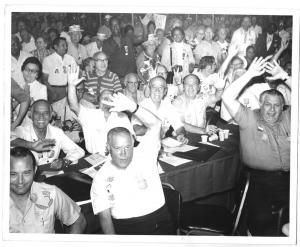Founded 1897 Affiliation AFL, AFL-CIO | Date dissolved 1979 Country Canada, United States | |
 | ||
Full name Amalgamated Meat Cutters and Butcher Workmen of North America Union merger | ||
The Amalgamated Meat Cutters (AMC), officially the Amalgamated Meat Cutters and Butcher Workmen of North America, was a labor union that represented retail butchers and packinghouse workers.
Contents
History
It was chartered by the American Federation of Labor (AFL) in 1897 to consolidate seven local unions in Chicago. The union was strongly committed to craft unionism. The union had 56 departments, each of which represented a different worker in the meatpacking industry. Workers in a given craft in a city had their own council, executive board, business agent and contract. The union was so divided internally that some members would continue working while others in the same city were on strike.
The union led one of the most notable strikes of the early 20th century in the United States. On July 12, 1904, 18,000 union members in Chicago walked off the job to win higher wages. They were joined by most of the other unions in the city. The union had actually reached agreement on an 18.5 cents-an-hour minimum wage for unskilled workers on July 6, but the Employers' Association of Chicago broke an agreement to not discriminate against union members. AFL President Samuel Gompers begged the union not to strike, but the Amalgamated walked out. Gompers subsequently refused to support the strike. But two AFL unions— the Stationary Firemen and the Stationary Engineers—refused to support the strike, and their members stayed on the job. The city's ice-houses stayed in operation, and most meat remained frozen and unspoilt. The Employers' Association helped break the strike by hiring thousands of unemployed African American workers as scabs. On August 18, 1904, when several black cattle herders chased stray stock outside the city's main stockyards, angry union members surrounded them and pelted the men with stones. Roughly 150 policemen formed a cordon to protect the strikebreakers, and angry union members replied with rocks and gunfire. More than 4,000 union members rioted.
The strike ended in defeat for the union on September 6, 1904. The international union itself would have been broken if not for the intervention of social reformer Jane Addams, who personally met with Armour and Company president J. Ogden Armour and convinced him to offer the union a desultory contract. Upton Sinclair's landmark novel, The Jungle, alludes to the 1904 strike.
The union also conducted a major strike from late 1921 through February 1922, perceived as a failure. Two black strikebreakers were lynched as a result of the strike: Jake Brooks in Oklahoma City on January 14, 1922, and an unnamed injured black meatpacker, kidnapped by the Klan from a Fort Worth hospital and lynched near the stockyards in February.
Mergers
Over time, the Amalgamated absorbed several other unions, including the International Fur and Leather Workers Union in 1955, the National Agriculture Workers Union in 1960, and the United Packinghouse Workers of America in 1968. In 1979, the AMCBW merged with the Retail Clerks International Union to form the United Food and Commercial Workers (UFCW).
